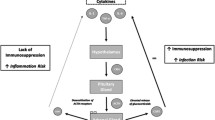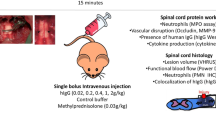Abstract
Multiple communicative pathways among the nervous, endocrine and immune systems facilitate physiological immunoregulation. Spinal cord injury (SCI) patients have decreased natural (NK cell) and adaptive (T cell) immune function and reduced blood levels of cellular adhesion molecules (CAMs) that participate in immune function and wound healing. We found decreased LFA-1 and VLA-4 on peripheral blood leukocytes in SCI patients and lower levels of CAMs in SCT patients with pressure ulcers than in those without them. SCI might affect immune cells and immune responsiveness by: (1) disrupting the outflow of signals from the sympathetic nervous system to lymphoid tissues and their blood vessels as well as the returning afferent signals from these tissues to the brain; (2) immunosuppression caused by the stressors affecting SCI patients; (3) interrupting returning signals to the CNS from the periphery thereby reducing facilitation of immunoregulatory CNS neurons and decreasing their activity; or a combination of all three. SCI patients may develop dysregulation of the sympathetic nervous system that is intimately involved in immune function. Chronic stress mediates immunosuppression by corticosteroids, catecholamines, endorphins and met-enkephalin. The hypothalamus coordinates the response to stress through the release of soluble products from the sympathetic nervous system and hypothalamic-pituitary-adrenal axis. Whereas the nervous and endocrine systems are not concerned with immunological specificity, they do influence the intensity, kinetics and localization of immune responses. Products of an activated immune system may generate feedback circuits capable of inhibiting, enhancing or regulating neuronal input. Immune system cells can produce neurologically active peptides including ACTH, CRF, growth hormone, thyrotropin, prolactin, human chorionic gonadotropin, endorphin, enkephalins, substance P, somatostatin and VIP. Cytokines are likely important mediators of the HPA response to immune stimuli.
Similar content being viewed by others
References
Cruse JM, Lewis RE, Bishop GR, Kliesch WF, Gaitan E: Neuroendocrine-immune interactions associated with loss and restoration of immune function in spinal cord injury and stroke patients. Immunol Res 1992;11:104–116.
Cruse JM, Lewis RE, Bishop GR, Kliesch WF, Gaitan E, Britt R: Decreased immune reactivity and neuroendocrine alterations related to chronic stress in spinal cord injury and stroke patients. Pathobiology 1993;61:183–192.
Kliesch WF, Cruse JM, Lewis RE, Bishop GR, Brackin B, Lampton JA: Restoration of depressed immune function in spinal cord injury patients receiving rehabilitation therapy. Paraplegia 1996;34:82–90.
Cruse JM, Lewis RE, Huggs M, Kliesch WF: Loss and restoration of immune function in spinal cord injury patients. FASEB J 1992;6: A1424.
Cruse JM, Lewis RE, Bishop GR, Kliesch WF: Alteration of immune system function in spinal cord injury patients. J Immunol 1993;150: 159A.
Cruse JM, Lewis RE, Bishop GR, Kliesch WF, Gaitan E, Britt R: Decreased immune reactivity and neuroendocrine alterations related to chronic stress in spinal cord injury and stroke patients. FASEB J 1994; 8:A113.
Cruse JM, Lewis RE, Bishop GR, Kliesch WF: Restoration of depressed immune function in spinal cord injury patients. FASEB J 1994; 8:A113.
Cruse JM, Lewis RE, Kliesch WF, Spencer C: Deficient cellular adhesion molecules and NK cell function in spinal cord injury patients with pressure ulcers. Abstr. 9th Int Congr Immunol 1995;539:3195.
Cruse JM, Lewis RE, Bishop GR, Lampton JA, Mallory MD, Bryant ML, Keith JC: Adhesion molecules and wound healing in spinal cord injury. Pathobiology, in press.
Stover SL, DeLisa JA, Whiteneck GG: Spinal Cord Injury: Clinical Outcomes from the Model Systems. Gaithersburg, Aspen, 1995, pp 100–116.
Turner ML: Cell adhesion molecules: A unifying approach to topographic biology. Biol Rev 1992;67: 359–377.
Collins T: Adhesion molecules in leukocyte emigration. Scientific American Science & Medicine Nov/Dec 1995; 28–37.
Dianzani U, Malavasi F: Lymphocyte adhesion to endothelium: Crit Rev Immunol 1995;15:167–200.
Yarkony GM: Pressure ulcers: A review. Arch Phys Med Rehabil 1994; 75:908–917.
Cavani A, Zambruno G, Marconi A, Manca V, Marchetti M, Giannetti A: Distinctive integrin expression in the newly forming epidermis during wound healing in humans. J Invest Dermatol 1993;101:600–604.
Jones LS: Integrins: possible functions in the adult CNS. Trends Neurosci 1996;19:68–72.
Van Waes C: Cell adhesion and regulatory molecules involved in tumor formation, hemostasis and wound healing. Head Neck 1995;17:140–147.
Somersalo K, Tarkkanen J, Patarroyo M, Saksela E: Involvement of β2-integrins in the migration of human natural killer cells. J Immunol 1992;149:590–598.
Mainiero F, Gismondi A, Milella M, Morrone S, Palmieri G, Piccoli M, Frati L, Santoni A: Long term activation of natural killer cells results in modulation of β1-integrin expression and function. J Immunol 1994; 152:446–454.
Male D, Rihman J, Pryce G, Tani T, Miyasake M: Lymphocyte migration into the CNS modelled in vitro: Roles of LFA-1, ICAM-1 and VLA-4. Immunology 1994;81:366–372.
Shimizu Y, Newman W, Gopal TV, Horgan KJ, Graber N, Beall LD, Van Seventer GA, Shaw S: Four molecular pathways of T-cell adhesion to endothelial cells: Roles of LFA-1, VCAM-1 and ELAM-1 and changes in pathway hierarchy under different activation conditions. Cell Biol 1991;113:1203–1212.
Vaziri ND, Eltorai I, Gonzales E, Winer RL, Pham H, Bui TD, Said S: Pressure ulcer, fibronectin, and related proteins in spinal cord injured patients. Arch Phys Med Rehabil 1992;73:803–806.
Ziegler MG, Ruiz-Ramon P, Shapiro MH: Abnormal stress responses in patients with diseases affecting the sympathetic nervous system. Psychosom Med 1993;55:339–346.
Colachis SC: Autonomic hyperreflexia with spinal cord injury. J Am Paraplegia Soc 1992;15:171–186.
Errico TJ, Bauer RD, Waugh T: Spinal Trauma. Philadelphia, Lippincott, 1991, pp 440–441.
Yashon D: Spinal Injury, ed 2. Norwalk, Appleton-Century-Crofts, 1986, pp 376–377.
Dunn AJ: Psychoneuroimmunology, stress and infection; in Friedman H, Klein TW, Friedman AL (eds): Psychoneuroimmunology, Stress, and Infection. Boca Raton, CRC Press, 1996, pp 25–46.
Felten SY, Felten DL, Bellinger DL, Olschowka JA: Noradrenergic and peptidergic innervation of lymphoid organs; in Blalock JE (ed): Neuroimmunoendocrinology, ed 2. Chem Immunol. Basel, Karger, 1992, vol 52, pp 25–48.
Madden KS, Livnat S: Catecholamine action and immunologic reactivity; in Ader R, Felten D, Cohen N, (eds): Psychoneuroimmunology, ed 2. San Diego, Academic Press, 1991, pp 283–310.
Mathison R, Davison JS, Befus AD: Neural regulation of neutrophil involvement in pulmonary inflammation. Comp Biochem Physiol 1993; 106:39–48.
Whalen MM, Bankhurst AD: Effects of β-adrenergic receptor activation, cholera toxin and forskolin on human natural killer cell function. Biochem J 1990;272:327–331.
Cunnick JE, Lysle DT, Kucinski BJ, Rabin BS: Evidence that shock-induced immune suppression is mediated by adrenal hormones and peripheral β-adrenergic receptors. Pharmacol Biochem Behav 1990; 36:645–651.
Van de Kar LD, Richardson-Morton KD, Rittenhouse PA: Stress: Neuroendocrine and pharmacological mechanisms; in Jasmin G, Cantin M (eds): Stress Revisited. 1. Neuroendocrinology of Stress, Methods Achiev Exp Pathol. Basel, Karger, 1991, vol 14, pp 133–173.
Kort WJ, Weijma IM: Chronic stress and the immune response; in Plotnikoff N, Murgo A, Faith R, Wybran J (eds): Stress and Immunity. Boca Raton, CRC Press, 1991, pp 523–536.
Pelletier G: Anatomy of the hypothalamic-pituitary axis; in Jasmin G, Cantin M (eds): Stress Revisited. 1. Neuroendocrinology of Stress, Methods Achiev Exp Pathol. Basel, Karger, 1991, vol 14, pp 1–22.
Orth DN: Corticotropin-releasing hormone in humans. Endocr Rev 1992;13:164–192.
Bonneau RH, Sheridan JF, Feng N, Glaser R: Stress-induced modulation of the primary cellular immune response to herpes simplex virus infection is mediated by both adrenaldependent and independent mechanisms. J Neuroimmunol 1993;42:167–176.
Cronstein BN, Kimmel SC, Levin RI, Martiniuk F: A mechanism for the antiinflammatory effects of corticosteroids: The glucocorticoid receptor regulates leukocyte adhesion to endothelial cells and expression of endothelial-leukocyte adhesion molecule 1 and intercellular adhesion molecule 1. Proc Natl Acad Sci USA 1992;89:9991–9995.
Burton JL, Kehrli ME, Kapil S, Horst RL: Regulation of L-selectin and CD 18 on bovine neutrophils by glucocorticoids: Effects of cortisol and dexamethasone. J Leukoc Biol 1995;57:317–325.
Felten DL, Cohen N, Ader R, Felten SY, Carlson SL, Roszman TL: Central neural circuits involved in neural-immune interactions; in Plotnikoff N, Murgo A, Faith R, Wybran J (eds): Stress and Immunity. Boca Raton, CRC Press, 1991, pp 3–25.
Roszman TL, Carlson S: Neural-immune interactions: Circuits and networks. Prog Neuroendocrin Immunol 1991;4:69–78.
Rozman TL, Brooks WH: Signaling pathways of the neuroendocrine network; in Blalock JE (ed): Neuroimmunoendocrinology. Basel, Karger, 1992, vol 52, pp 170–190.
Faith RE, Murgo AJ, Plotnikoff NP: Interactions between the immune system and the nervous system in Plotnikoff N, Murgo A, Faith R, Wybran J (eds): Stress and Immunity. Boca Raton, CRC Press, 1991, pp 287–303.
Blacock JE: A molecular basis for bidirectional communication between the immune and neuroendocrine systems. Physiol Rev 1989;69: 1–32.
Rivier C: Role of interleukins in the stress response; in Jamsin G, Cantin M (eds): Stress Revisited. 1. Neuroendocrinology of stress. Methods Achiev Exp Pathol Basel, Karger 1991, pp 63–79.
Hall NR, O'Grady MP, Farah JM: Thymic hormones and immune function: Mediation via neuroendocrine circuits; in Ader R, Felten D, Cohen N (eds): Psychoneuroimmunology, ed 2. San Diego, Academic Press, 1991, 2nd edition pp 515–528.
Author information
Authors and Affiliations
Rights and permissions
About this article
Cite this article
Cruse, J.M., Keith, J.C., Bryant, M.L. et al. Immune system-neuroendocrine dysregulation in spinal cord injury. Immunol Res 15, 306–314 (1996). https://doi.org/10.1007/BF02935314
Issue Date:
DOI: https://doi.org/10.1007/BF02935314




